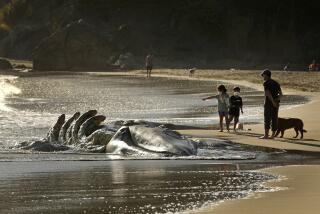Oil spill’s effect on wildlife difficult to tally
- Share via
Reporting from Venice, La., and Los Angeles — In a region teeming with wildlife, so far there have been few signs of significant animal die-offs attributed to the Gulf of Mexico oil spill.
Scientists offered one explanation for this puzzle Thursday: Birds and marine life that spend most of their lives at sea are likely being killed by the oil, but are dying far offshore.
“If birds are impacted by oil and they die there, they sink,” said Roger Helm, chief of environmental quality for the U.S. Fish and Wildlife Service. The same goes for manatees, dolphins and whales that may succumb to oil many miles out to sea, leaving little evidence of their loss.
Federal officials acknowledged in a conference call Tuesday that the numbers of affected wildlife appeared low so far, with the exception of sea turtles.
But they cautioned that the tally only counts injured animals found near the shore or dead animals washed up on beaches. The long-term effects on wildlife and habitat are expected to be monumental.
“This spill is significant. In all likelihood it will affect wildlife in the gulf and the North American continent for years,” said Rowan Gould, Fish and Wildlife acting director. “There’s been a small number of visibly oiled birds, but what we can’t see are the birds and mammals that spend the bulk of their times offshore.”
The Exxon Valdez spill was thought to have killed 250,000 sea birds. So far, only 23 birds have been found dead as a result of the BP spill.
Another 12 oiled birds have been captured; of those, eight have been cleaned and four released, officials said. The number would change significantly if the oil hits shore-dwelling birds, which make up the bulk of the birds in the area. “If this comes onshore, a lot of birds are going to die,” Helms said.
Sea turtles appear to the hardest hit, with reported strandings four times higher than the five-year average. Steve Murawski, chief science advisor of NOAA Fisheries Service, said 156 turtles had died, most of them young Kemp’s Ridley turtles, a protected species.
Officials said turtles and other sea life, including dolphins and whales, had been seen from planes, surfacing and swimming in the oil slick.
“We believe that most of the impact to turtles will not be readily seen because it’s happening offshore,” said Barbara Schroeder, a turtle expert with the National Oceanic and Atmospheric Administration. “Most of those mortalities will never be counted.”
Only a small number of turtle necropsies have been performed, officials said, and no evidence of oil-related death was detected. But examinations are ongoing.
In addition, 12 bottlenose dolphins have been found dead, although no cause is known.
Logistically, it has been difficult to organize wildlife rescue because of the spill’s distance from shore, making daily searches in deep water impractical and contingent on good weather.
Also, authorities have limited access to the waters near the leaking well. At one point, hundreds of boats traversed the area assisting in efforts to stop the leak. But that number was severely curtailed, in part because of the delicacy of the work maneuvering robotic equipment in deep water. Authorities wanted to minimize turbulence around the wellhead.
In other cases, boats that had earlier carried rescue workers searching for struggling animals were ordered back to shore, frustrating some of the specialists who have gathered to help. One organization hired by BP to rescue and rehabilitate oiled birds complained of an overly bureaucratic process that leaves them out of planning and restricts them from going to certain federally managed areas to look for injured birds.
“We’ve felt like we’ve been wasted,” said Jay Holcomb, director of International Bird Rescue Research Center, which was hired by Tri-State Bird Rescue and Research Inc. on behalf of BP.
Abdulrahim reported from Venice, La., and Cart from Los Angeles.
More to Read
Sign up for Essential California
The most important California stories and recommendations in your inbox every morning.
You may occasionally receive promotional content from the Los Angeles Times.












